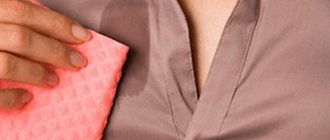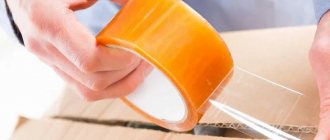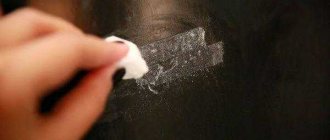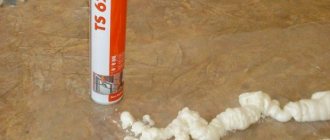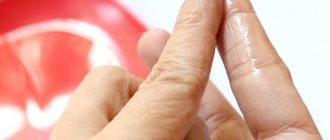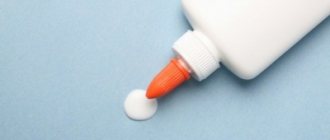Often the simple task of removing glue from linoleum turns into a headache, especially if you don’t know how to properly approach the problem and what to use. And most importantly, how not to damage the polymer coating with excessive zeal.
Sometimes only mechanical cleaning of linoleum helps.
Ways to remove fresh glue from linoleum
Even a person with little knowledge of this matter can offhand come up with at least four or five ways to remove adhesive residues.
Most often the list looks like this:
- Acetone, alcohol mixed with water and acetic acid;
- Any solvent available on the farm;
- Detergent, including laundry soap and jeans detergent;
- Branded products for removing paint and oil stains;
- Sunflower oil and hydrogen peroxide.
It is clear that all of the listed means, to one degree or another, allow you to remove some of the glue and paint, especially if these are fairly common dyes used in home repairs. The problem is to clean the adhesive from linoleum from the floor without damaging the coating and without spending the whole daylight hours on the removal procedure. Therefore, choosing technology and means that allow you to best remove glue from linoleum must take into account the chemical nature of the adhesive mass.
Advantages of adhesive installation
The main types of linoleum used in construction are polymer or natural roll coverings. For laying both of them, glue can be used as a finishing coating on the floor.
Adhesive flooring
Advantages of adhesive installation:
- reliable adhesion of the finishing material to the base;
- imparting overall strength to the coating;
- eliminating the risks of displacement and deformation of the canvases under dynamic loads on the floor;
- increase in service life;
- high-quality joining of roll sheets;
- reduction in the time of natural shrinkage (change in length) of canvases.
- reducing the value of residual deformation (memory) of linoleum under point influences;
- increasing resistance to moisture on the inner layers of the fabric.
The widespread belief that by laying linoleum on the floor without glue, you can reduce material costs, is not always confirmed by reality. The increased service life of the glued coating more than compensates for the cost of glue
Consequences of dismantling linoleum with glue
The only disadvantage of adhesive flooring is the impossibility of maintaining all the performance qualities of the coating for further use in the event of dismantling.
How to remove dried super glue from linoleum
Oddly enough, the greatest number of fears and problems arise in connection with the removal of superglue. Light, very mobile liquid penetrates into the smallest pores and cracks of the linoleum coating. Therefore, it is clearly not possible to simply scrape off the stain; in addition, the material dries within a few seconds, which means that simply wiping it off with a napkin, as in the case of other types of adhesive materials, obviously will not work.
There are several ways to remove super glue from linoleum:
- White Spirit. Easily removes all brands of cyacrine compositions, but you must wear gloves, otherwise an allergic reaction of the skin of your hands is possible;
- The easiest way to remove super glue from linoleum is with branded “Anti-glue”; almost every self-respecting manufacturer of adhesive cyanoacrylate simultaneously produces products for cleaning it from various surfaces, including linoleum.
The majority of products that allow you to clean glue from linoleum are based on the same white spirit.
If it is not possible to use either option, you can try to clean the glue using sequential treatment, first with acetic acid or alcohol, then treated with a small amount of castor oil. This treatment only softens the dried glue, then you just need to carefully clean the remaining cyacrine with a wooden spatula, and wash the linoleum before the castor oil causes stains to appear on the PVC layer.
The main feature of superglue
Superglue was invented in the mid-twentieth century in America as a result of experiments to create a material for optical sights. The resulting substance did not meet the requirements of the developers, but due to its super property of instantly gluing everything together, it was patented. Superglue, Super Moment, and Second contain one substance that can instantly harden when interacting with the slightest particles of moisture from the air. This is cyanoacrylate. It immediately bonds the surfaces it comes into contact with. Moreover, the gluing is very strong. Therefore, removing traces of glue is quite problematic.
Superglue of any brand contains cyanoacrylate as a base.
Unfortunately, this glue can stick to any surface, so you need to work with it very carefully. You can wipe the stain off the surface if it is not cotton or wool, with which the glue can react violently before it ignites.
How to remove super glue from linoleum using chemicals
In some cases, surgical intervention in the situation helps. For example, if super glue drips onto the linoleum in front of the owners, then it is quite possible to remove the stain using chemicals and reagents available in the household.
Dimexide
An aqueous solution of dimethyl sulfoxide is sold in any pharmacy under the trade name “Dimexide”. The product allows you to remove glue, but only if the stain was recently planted. Superglue adheres perfectly to slightly moistened surfaces, and is not stopped by oil, dust or detergents.
Dimexide may cause hand skin irritation
To quickly remove and wash the glue from linoleum, you need to treat the stain with a few drops of dimexide. If you don’t have one at hand, then any water-removing drug, for example, alcohol, will do. It will significantly slow down the setting of superglue, which will allow you to gain time, and sometimes simply remove the glue from the linoleum mechanically.
Solvents and gasoline
Straight-run gasoline, also called purified or “Galosh,” can be found in households. It is approximately equal in effectiveness to white spirit, but does not irritate the skin of the hands. Both reagents will not completely remove the glue from linoleum, but at the same time they can significantly slow down the polymerization process and soften already dried areas of the stain.
Polar solvents are most effective in removing glue from linoleum.
Gasoline and most hydrocarbon-based organic solvents can perfectly cope with most shoe and rubber adhesive compositions. For example, you can remove instant glue from linoleum, even if the stain is several days or even weeks old.
The product can be used in combination with other solvents for pentaphthalic and oil paints. But it is not recommended to use it in combination with Dimexide; the effectiveness of double use of cleaning products is significantly reduced.
Important! You should not even try to clean linoleum from glue using solvents intended for alkyd enamels and nitro paints.
Any of these reagents will most likely dissolve the outer decorative layer and lead to damage to the linoleum.
You can compensate for any solvent spilled on linoleum with regular oil.
Alcohol
High concentration ethanol can be used to remove traces of a wide range of adhesives. For example, alcohol will help remove mouse glue from linoleum. Moreover, alcohol compositions with a strength of 70-96% allow you to clean any floor materials without harming the decorative coating.
If traces of glue do not come off the first time, then it is quite possible to clean the dirt on the surface of the linoleum with the help of a small compress placed on the remaining adhesive mass for 10-15 minutes.
Alcohol removes everything from linoleum except paint
Acetone
A very strong solvent, if used improperly, can lead to destruction and washing out of paints on the surface of linoleum. You can clean Moment or Cosmofen with acetone, but handling the reagent requires special care. Firstly, the solvent evaporates quickly, and inhalation of vapors can lead to poisoning, and secondly, the cleaner dries out the skin of your hands.
The procedure for cleaning traces of glue from linoleum is as follows:
- Use laundry soap to circle the stain to prevent acetone from getting on the clean surface of the linoleum;
- Place a swab moistened with acetone on the stain;
- After 10-20 minutes, remove the compress, add alcohol and remove the remaining glue mechanically.
A mixture of alcohol and acetone can effectively remove adhesive from tape from linoleum. Different brands of coating use different proportions, so before you get down to business and try to remove linoleum glue from the floor, it would be best to practice on the remaining piece of linoleum panel.
Scotch tape marks are easily washed off with a VD-shkoy
Remove stains
Before removing stains of unknown origin from linoleum, remember a few rules:
- First, always try to remove the stain with a warm solution of laundry soap; this method helps to cope with even severe stains;
- Do not use too hot water - yellow or whitish stains may form on the linoleum;
- Undiluted ammonia and soda cause linoleum to deteriorate and become dull; when removing stains, do not rub for too long with these products;
- Do not apply the cleaner directly to the stain, especially if it is in a visible place. Try it on an inconspicuous area first and see the results.
Remove iodine and brilliant green
Any detergent containing chlorine, for example, “Belizna”, or a paste of soda and water, left overnight on the stain, will help remove iodine stains. Fresh drops of iodine can be wiped with a cut of a raw potato. But, if you are not in a hurry, the iodine itself will evaporate in about a month, leaving no trace, since it is a volatile substance.
- Stain removers for fabrics (Vanish, Amway and others). Apply the product to a sponge, saturate the stain well, and after half an hour, rinse with warm water;
- Any alcohol. Immediately wipe the stain well; if it does not disappear, soak a rag in alcohol, place it on the stain and leave for an hour;
- Sprinkle baking soda over the entire surface of the stain, and apply table vinegar on top. As the foam forms, the brilliant green will gradually come off. Repeat the process until the stain disappears completely.
How to remove brilliant green if the stain is old?
- Soak a rag in table vinegar with the addition of potassium permanganate and place it on the stain;
- Wait until the greenery turns pink, then brown, rinse with warm water;
- Prepare a solution of hydrogen peroxide and vinegar;
- Apply to stain until discolored.
- Rinse the problem area with water.
Wipe off the felt-tip pen, wash the marker and ink
Most often, only a warm soapy solution will be enough, but if the marker is alcohol-based, you will have to use alcohol, cologne or vodka. It is advisable to immediately cover fresh ink marks with salt and moisten them with vinegar; try wiping marks from a ballpoint pen with a wet match head; sulfur removes such stains well.
How to wash a marker that no product can remove? Try spraying the painted area with regular hairspray or aerosol deodorant, then wipe with a damp cloth.
Treating the stain with pumice stone or fine-grade sandpaper will help remove ink or permanent marker (in some cases, a melamine sponge helps). Gently clean the area, then wipe with a flannel cloth soaked in linseed oil.
Remove the burnt from the hot
- Clean the burnt area from the black charred edge;
- Mask the cleaned surface with wood putty or sealant (it is advisable to choose the appropriate color);
- After hardening, touch up with acrylic paint if necessary.
If the linoleum is hopelessly damaged in a visible place, there is nothing left to do but cover the defect with a rug.
You can replace the damaged piece with a new one.
To do this, use a knife to cut out the area of contamination, trying to ensure that it is a solid fragment of the pattern, or a geometric figure of the correct shape (for plain linoleum).
If there are unused pieces left, select and cut out the same fragment; if not, make a patch in the form of an original design solution (diamonds or circles in a contrasting color).
Sand the edges of the cut patch with sandpaper to remove unevenness, glue with special glue, fill the seams with colorless sealant or match the color of the linoleum.
How to remove glue from linoleum using folk remedies
Sometimes, instead of toxic and not always effective chemicals, it makes sense to try simpler cleaners based on what is available in the kitchen of any home. It is possible that folk remedies are in some ways inferior to special cleaners and solvents, but at the same time they are more accessible and safer for everyday use.
Lemon acid
In fact, citric acid is a very strong and aggressive chemical compound, so trying to clean superglue or any other stain by simply dipping a swab into the powder means putting yourself at risk of getting acid burns on your fingers.
In order to clean superglue, acrylic material, or any water- or water-based adhesive, you need to pour a small amount of powder directly onto the stain and add a drop of water. After 15 minutes, the lemongrass needs to be neutralized with a soda solution and the remaining glue must be carefully removed from the linoleum.
Oils
Vegetable oil itself does not wash out any adhesive compositions well. It can be used to remove non-drying adhesives. Many experts recommend using an emulsion of white spirit and oil. This mixture easily washes away residues from tape and drying oil.
With proper patience, superglue on linoleum can also be cleaned with oil; the smeared stain is left for 10-12 hours, after which the softened structure is wiped off from the linoleum with a wooden scraper.
Soda and salt
The baking soda solution or powder form acts like a catalyst. It is believed that a slightly alkaline environment sharply increases the rate of polymer hardening, so soda can only be used in the long term. Glue on linoleum treated with soda will turn into a hard crust in a week, after which the stain can be removed from the coating.
Salt, on the contrary, can slow down and even stop the polymerization process for a short time, but it is clearly not possible to completely remove the adhesive stain from linoleum.
Vinegar
To treat adhesive contamination, use it together with lemon juice or citric acid. When applying the mixture to a fresh stain, the glue becomes viscous and does not harden for a certain time. Therefore, it is possible to remove the maximum amount of mass. Use a metal scraper or knife blade to scrape off the stain and grab it with a clean, dry cloth.
Important! This may not be the most effective way to deal with glue stains, and it’s not possible to clean everything right away, but vinegar and lemon juice are almost always at hand, and you don’t need to look for a solvent or acetone.
The faster you treat the stain, the greater the chance that you will be able to clean the stain or at least make it less noticeable.
Hydrogen peroxide
At first glance, the disinfectant is of little use; in fact, upon contact with organic matter, peroxide decomposes, releasing water and very active oxygen, which literally eats up super glue.
Peroxide can discolor stains on linoleum
The only drawback is the strong oxidizing ability of the product, so you can not only clean the glue from the linoleum, but also, by carelessness, make a brown stain on the floor surface. Once the stain has disappeared, the residue should be washed off immediately with soapy water.
Temperature difference
You can try to remove it with a piece of ice wrapped in a plastic bag. When strongly cooled, the linoleum contracts and the adhesive partially peels off from the polymer coating. Sometimes, instead of ice, cans are used to refill gas lighters. If you press the valve to a drop of dried super glue and release a small amount of butane, the surface temperature of the linoleum will drop to -10 -15 ° C, which is quite enough to clean the stain.
General information
Glue CA500-200 (Cosmofen SA-12) in original packaging
Superglue may have different names, but in any case it contains cyanoacrylate
. This must be reflected on the label. The substance has a fairly strong odor and is difficult to confuse with anything else.
When it hits the surface of laminate or linoleum, it hardens, turning first into a transparent and then into a whitish coating.
The final hardening of the glue occurs within several hours.
Glue deposits on the laminate surface
Removing such plaque is mechanically problematic,
That's why they use the chemical method.
There are several ways to remove superglue.
The whole question is only about the speed of removal and possible unpleasant consequences for humans.
The simplest way is to use special compounds based on polypropylene carbonate, which is a natural solvent of cyanoacrylate.
The method is good for everyone, except for one thing - polypropylene is toxic (hazard class 1), so its use is not recommended.
Another way is to use regular water.
Methyl cyanoacrylate dissolves in it, although slowly. Complete dissolution of a glue stain several centimeters in diameter occurs in about a day. This method is also unacceptable, since it is impossible to immerse the floor covering in water for such a long period of time - the laminate will simply deteriorate.
Therefore, the third method is used
It uses the drug dimexide
In fact, dimemxide does not dissolve the glue, but it does react with the outer layer of cyanoacrylate.
Spreading over the area of contact between the adhesive and the coating, it destroys the molecular bonds, which leads to the separation of the adhesive from the coating.
Let's consider the sequence of actions that need to be done,
To remove glue stains from laminate or any other flooring:
Action No. 1 Preparation of materials
Cotton pads and dimexide
1
To remove stains from the surface, you will need cotton pads and a certain amount of dimexide.
Dimexide is applied to a cotton pad
2
The cotton pad is ready. Dimexide is applied to a cotton pad. Now you can start removing the glue.
Action No. 2 Pre-treatment
Circular movements with a cotton pad over the entire surface of the adhesive spot
1
First, it is necessary to saturate the adhesive layer on the coating as much as possible with dimexide. This is done by using a cotton pad in a circular motion over the entire surface of the adhesive spot.
The surface should be cleaned of glue and dimexide residues using a rag.
2
Gradually, dimexide will begin to penetrate between the glue and the surface, and the glue stain will partially collapse and fall off. In this case, its fragments will remain on the cotton pad.
Remaining parts of glue
3
In about 1-2 minutes, from 50 to 80% of the glue will be removed, and only the most well-adhered fragments will remain on the surface.
This suggests that dimexide is not enough and it is advisable to saturate the disk with it again.
How to remove glue from linoleum: mechanical cleaning
Contamination on linoleum flooring can be simply cleaned off with caustic soda or dishwashing detergent. The method is simple, but requires quite a lot of time, effort and patience. In addition, the abrasive always removes the gloss, and after cleaning the glue, a matte stain will remain on the linoleum.
Working with a sponge requires incredible patience
Melamine sponge
It is easier, although not faster, to wash the glue from the linoleum with a melamine sponge. The material is rigid enough to erase microparticles of dirt, and at the same time viscous to capture exfoliated fragments.
It is imperative to work with gloves, moistening the stain on the linoleum with literally a drop of water. To simplify the process, the sponge can be attached to a long bolt, and the device itself can be installed in the screwdriver chuck.
Important! If you work intermittently to allow the linoleum to cool, then it is quite possible to scrub the surface without visible traces of cleaning.
Competent linoleum repair (video)
When carrying out repair work, there is a high probability of contamination of the linoleum surface. It may lose its shine, streaks may remain on it, putty and primer may be spilled on it. After whitewashing, unsightly stains remain on the linoleum. Cleaning with soapy water or chemicals designed for working with linoleum will help give linoleum a beautiful appearance. It can be very easy to update linoleum if you know some tricks and techniques that can easily be found on the Internet on specialized sites.
The most common flooring in our homes is linoleum. It washes well, does not require special care, and thanks to the abundance of colors, it can be matched to any interior. Unfortunately, not all stains and dirt can be removed from linoleum with water, but don’t rush to get upset if you can’t deal with the problem right away.
Use tips on how to remove certain types of stains and dirt from linoleum floors.
How to remove super glue from linoleum if all else fails (drastic measures)
After you have tried all possible chemicals and methods for removing super glue, you can use the oldest and most reliable method. A stain of any size, even from the strongest and most durable adhesive compositions, can always be removed with a regular knife.
Most often, a scalpel, a safety razor blade, or a sharp hacksaw blade for cutting metal is used for scraping. The process is quite long, but if you combine scraping with periodic heating and cooling of the stain, you can remove a drop of superglue in just a couple of hours.
Useful tips
If you do not have any experience in removing adhesive residues from linoleum or parquet, then it is best to try to limit yourself to two products - white spirit and hydrogen peroxide. In the first case, you just need to place a swab with liquid on the spot and leave it like that for 30-40 minutes. Next, use a dry, clean napkin to trace the glue drop; if a trace appears, it means that the dissolution process has begun, and you can continue to fight in the same spirit.
After removing the glue, the linoleum must be washed with soapy water.
If not, then use peroxide in the same way. Firstly, it will kill the remnants of white spirit and rid the room of the smell, and secondly, it will soften and corrode everything that remains after the solvent. All that remains is to clean off traces of peroxide so as not to burn the linoleum.
Recommendations
The following tips will help you remove glue from glass:
- If home methods are ineffective, you can resort to special means.
- When cleaning the glue with a knife or blade, you can damage the glass and leave scratches on it.
- It is recommended to use cleaning chemicals in a well-ventilated area using rubber gloves.
- In the process of cleaning the glass, when the glue begins to soften, it is better to remove it immediately so that it does not spread over an even larger area.
- When removing glue, you must try not to get solvents on rubber, plastic and metal parts.


